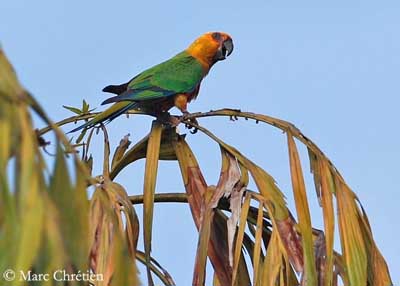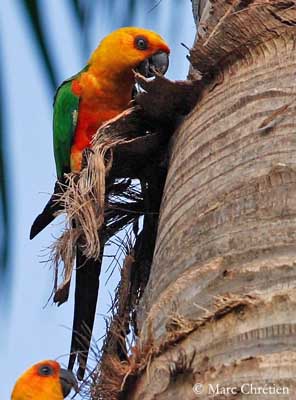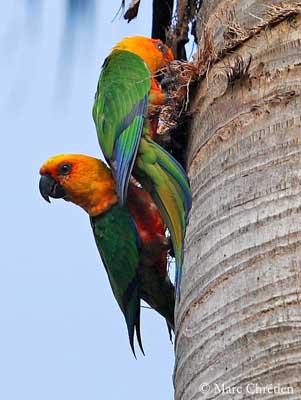
Sun Parakeet
Aratinga solstitialis
Psittaciforme Order – Psittacidae Family
BIOMETRICS:
Lenght : 30 cm
Weight : 110-130 g
LONGEVITY: Up to 30 years
DESCRIPTION:
Sun Parakeet is well known as popular cage bird, due to its bright colours and its ability for talking.
Adult male has often mixed colours such as red, orange and yellow overall. Wings show some green and blue feathers. Tail is usually olive-green. Mantle, back and upper wing coverts are often yellow.
Its colour has yellow-orange glow, similar to gold.
Bill is black. Eyes are dark brown, with bare greyish-white eye-ring. Legs and feet are pinkish-brown.
Both sexes are similar, but male has flatter forehead and square head, whereas female has rounder and smaller head than male.
Fr: Conure soleil
All : Sonnensittich
Esp : Aratinga Sol
Ital : Conuro del sole
Nd : Zonparkiet
Sd : Solparakit
Photographs by Marc Chrétien
His website: MURINUS
Text by Nicole Bouglouan
Sources:
HANDBOOK OF THE BIRDS OF THE WORLD vol 4 by Josep del Hoyo-Andrew Elliott-Jordi Sargatal - Lynx Edicions - ISBN: 8487334229
PARROTS OF THE WORLD – An Identification Guide – by Joseph M. Forshaw – Princeton University Press – ISBN 0691092516
Wikipedia (Wikipedia, The Free Encyclopedia)

Juvenile shows more green than in adults. The bright coloured plumage appears little by little after several moults, about 6 to 8 months after hatching.
Colours become brighter as the bird matures, and Sun Parakeet reaches its sexual maturity at two years.
We can find two subspecies:
A.s.solstitialis has plumage usually deep yellow, pale grey bill and white eye-ring. It lives in Central Guyana.
A.s. pintoi, is generally paler in all colours. It lives in north-eastern Brazil.
VOICE: SOUNDS BY XENO-CANTO
Sun Parakeet gives screeching “screeek, screeek” in flight, rapidly repeated. When perched, it utters chuckling sounds, and high-pitched wheezy note.

HABITAT:
Sun Parakeet lives mainly in wooded savannahs, in open forests, in dry woodlands or in scrublands along forest edges. It can be found locally in seasonally flooded scrub forests along the banks of the Amazon River, and in secondary growths.
RANGE:
Sun Parakeet lives in north-eastern Brazil, Guyana and French Guyana, south-east Venezuela, northern Amazon and Surinam.
BEHAVIOUR:
Sun Parakeet is resident in its range, and can perform local dispersions for food. It is a gregarious species, often seen in flocks of up to 20 birds or more. They are noisy, perched on treetops where they can find fruits, flowers, seeds and nuts.
However, they are able to be very quiet when resting or feeding lower in trees and bushes, sometimes close to the ground, remaining well concealed among low leaves and branches.
Sun Parakeet likes to chew numerous things, spending most time “working” its nest-site with the bill, tearing out chips of wood or bark.

FLIGHT:
Sun Parakeet performs swift, direct flight over open areas.
REPRODUCTION:
Sun Parakeet nests in holes in palm-trees. Breeding and nesting behaviours in wild are little known.
In captivity, female lays 4 to 5 eggs. Incubation lasts about 23 days, shared by both parents. Young can fly about 8 weeks after hatching.
Adults are aggressive during nesting period, and protect strongly the nest-site against intruders.

DIET:
Sun Parakeet feeds on fruits, flowers, seeds and nuts. It finds its food in trees and bushes. It also consumes insects.
PROTECTION/THREATS/ STATUS:
Sun Parakeet is locally common and has restricted habitat.
It is very popular as cage bird, and numerous birds are trapped for live-bird trade.